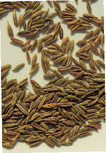

The “seeds” of cumin.
THE SPICE CUMIN, OR CUMMIN (archaic), derived from the ground “seeds” of the plant, is an essential component of east Asian as well as Mexican cuisine and for the same reason. Arab traders took the spice to India as well as to Spain. From Spain, it traveled to the New World.
In the Bible, cumin was used as a kind of contribution for worship: “Woe to you, teachers of the law and Pharisees, you hypocrites! You give a tenth of your spices—mint, dill and cummin. But you have neglected the more important matters of the law—justice, mercy and faithfulness. You should have practiced the latter, without neglecting the former” (Matthew 23:23, NIV).
Cumin, Cuminum cyminum, is also mentioned in the Old Testament, unlike dill, mint, or rue. There is a great deal of similarity among the words used for cumin in Hebrew, Greek, and Arabic, lending strong support to the identity of this popular herb in the holy books. Cumin has been used for thousands of years in Egypt and surrounding countries (Murray 2000).
A relative of dill, cumin is an easily grown annual plant. Like most herbs, cumin is planted in the winter and harvested in May in the Middle East. It is grown for its seeds. The fruits of cumin contain “seeds,” each being technically a mericarp; the fruit splits rather than opening. Cumin seeds are usually ground into a spice that is used to flavor bread, pastries, and other dishes. Once ground, cumin soon loses its pungency. Cumin is mentioned three times in Isaiah 28 (Isaiah 28:25–28).

Cumin in flower in the Jordan River Valley, Jordan.

Cumin ready for harvest in northern Syria. Farmers in this part of Mesopotamia grow cumin as a cash crop because of the culinary demand for the spice.
Cumin must have been well known to the target audiences of the Old Testament, as the Isaiah reference suggests, as well as to the hearers of Jesus. The New Testament reference indicates how highly valued cumin was as a spice.